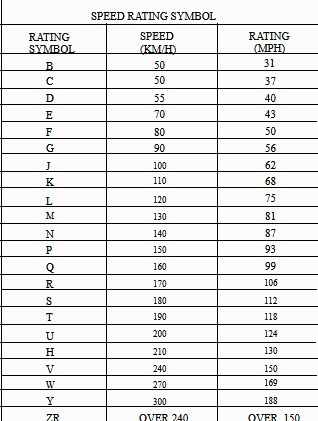(bead to tread) to the width of a tire (sidewall to sidewall). It is height divided by width. A 80-series tire, for example, has a section height that is 80 percent of the section width.
As the aspect ratio becomes smaller, the tire becomes more squat (wider and shorter). A 60-series tire would be "short" and "fat." whereas an 80-series tire would be "narrower" and "taller."
Load Index and Speed Rating
The term load index, or loud range. is used to identify a given size tire with its load and inflation limits when used in a specific type of service. The load index of a tire and proper inflation pressure determines how much of a load the tire can carry safely.
A letter identifies the load index for most light trucks. These letters being B. C. or D. A tire with a B load rate is restricted to a load specified at 32 psi. Where a greater load-carrying ability is required, load rate C or D tires are used.
Passenger vehicle tires come with a service description added to the end of the tire size. These service descriptions contain a number, which is the load index, and a letter, which indicates the speed rating. The load index (fig. 8-32) represents the maximum load each tire is designed to support. Because the masimum tire load capacity is branded on

Figure 8-32. - Load index chart for a passenger vehicle.
the sidewall of the tire, the load rate is used as a quick reference. Speed ratings (fig. 8-33) signify the safe top speed of a tire under PERFECT conditions.
Maximum Inflation Pressure
The maximum inflation pressure. printed on the sidewall of a tire, is the highest air pressure that should be induced into the tire. The tire pressure is a "cold" pressure and should be checked in the morning before operating the vehicle.
In most parts of the world, fall and early winter months are the most critical times to check inflation pressures because the days are getting colder. And since air is a gas, it contracts when cooled. For every 10F change in ambient temperature, the inflation pressure of a tire will change by 1 psi. It will go down with lower temperatures and up with higher temperatures. The typical difference between summer and winter temperatures is about 50F that results in a loss of 5 psi and will sacrifice handling, traction, durability, and safety.
Tire Grades
The Department of Transportation requires each manufacturer to grade its tires under the Uniform Tire Quality Grade (UTQG) labeling system and

Figure 8-33. - Speed rating chart for a passenger vehicle.
Continue Reading